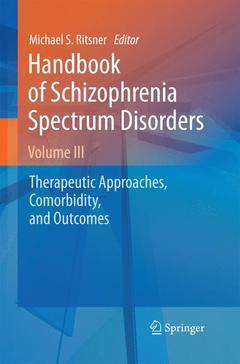Description
Handbook of Schizophrenia Spectrum Disorders, Volume III, 2011
Therapeutic Approaches, Comorbidity, and Outcomes
Coordinator: Ritsner Michael S.
Language: English
Subjects for Handbook of Schizophrenia Spectrum Disorders, Volume III:
Publication date: 10-2014
462 p. · 15.5x23.5 cm · Paperback
Publication date: 04-2011
462 p. · 15.5x23.5 cm · Hardback
Description
/li>Contents
/li>Comment
/li>
Foreword. Schizophrenia Spectrum Disorders: Insights from views across 100 years. -1.Recovery in schizophrenia: perspectives, evidence, and implications. -2.The magic shotgun: does it fit the clinician and will it point at schizophrenia? -3.Advancing neuroprotective-based treatments for schizophrenia. -4.Prevention and early intervention in at risk states for developing psychosis. -5.Early improvement and its predictive validity in first-episode schizophrenia patients. -6.Antioxidants as a treatment and prevention of tardive dyskinesia. -7.Electrophysiological imaging evaluation of schizophrenia and treatment response. -8.Coping with schizophrenia: measuring coping styles, patterns and temporal types. -9.Interventions targeting social and vocational dysfunction in individuals with a schizophrenia spectrum disorder. -10.Revisiting cognitive remediation for schizophrenia: Facing the challenges of the future. -11.Individual psychotherapy for schizophrenia: an overview of its history, recent developments and new directions. -12.An overview of cognitive behavior therapy in schizophrenic spectrum disorders. -13.Schizophrenia and medical illness: consequences of schizophrenia or its treatment? -14.The interface of cannabis misuse and schizophrenia-spectrum disorders. -15.Schizophrenia and comorbid substance abuse – pathophysiological and therapeutic approaches. -16.Suicidality and outcome in schizophrenia patients.-17.The relationship between religiousness/spirituality and schizophrenia: implications for treatment and community support. -18.The ethical ramifications of biomarker use for mood disorders. -Afterword. The future of the schizophrenia construct and acquisition of new knowledge.
Classification of the schizophrenia spectrum disorders
Neurobiological challenges
Phenotypic and endophenotypic presentations
Therapeutic approaches




